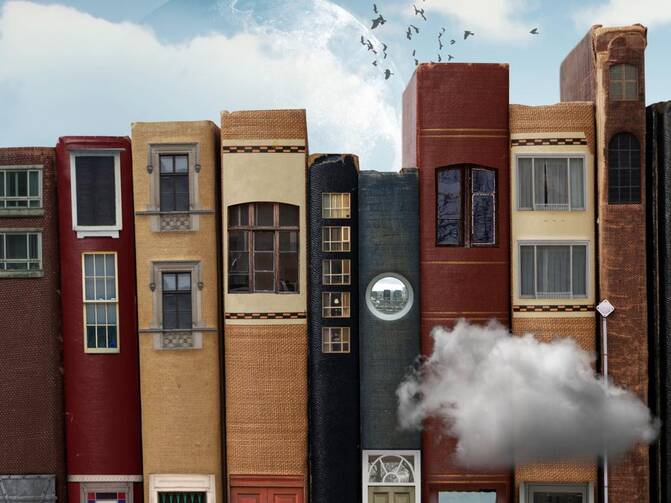“The Irish always wrote good letters. If they could write.”
–William Kennedy, Billy Phelan’s Greatest Game (1978)
William Kennedy’s point in this passage—about illiteracy, poverty, vanished history—is a valid one. By now, though, it is a truth universally acknowledged that the Irish write no matter what. Their literary accomplishments remain wildly out of proportion with the size of Ireland itself, which you can traverse, east to west—from Dublin’s Sandymount Strand to the fabled fields of Athenry—in about three hours. It might take you just as long to span the two-and-a-half traffic-choked miles between the Brooklyn Bridge and Holland Tunnel, especially every March 17.
Then again—for New York lovers of literature, anyway—every day seems a bit like St. Patrick’s Day. You can stroll over to 42nd Street right now to see John Patrick Shanley’s explosive Bronx Irish Catholic play, “Doubt.” Or you can pick up a new edition of dazzling short stories by another “B.I.C.,” the criminally underread Elizabeth Cullinan. The Library of America’s latest volume is a sweeping collection of journalism by the legendary Queens-born Jimmy Breslin, edited by fellow ink-stained Hibernian Dan Barry. And if you are a reader who plans ahead, Colm Tóibín will soon release the much-anticipated follow-up to his 2009 best seller, which became an Oscar-winning film starring Saoirse Ronan. Millions of New York Irish can tell you about the journey implied in Tóibín’s titles: Brooklyn, then Long Island.
All of which invites a closer look at one more new book. Plentiful Country: The Great Potato Famine and the Making of Irish New York, by Tyler Anbinder, is an impressive study of the 1840s Irish. But with all due respect to Anbinder’s extensive archival work (and publishing’s penchant for titular hyperbole), surely New York was “made” Irish by more than the piles and piles of Emigrant Savings bank documents so ably pored over in Plentiful Country. Surely there is a sweeping novel, play or memoir, or brilliant collection of stories or poems, that better captures the New York Irish in all their striving, violence and power. Isn’t there?
Chicago has James T. Farrell’s Studs Lonigan. New Orleans has John Kennedy Toole’s Ignatius J. Reilly. Boston has Edwin O’Connor’s Last Hurrah. And William Kennedy’s Albany Cycle series has “ironweeds” like Billy and Francis Phelan.
What, then, is the greatest book ever written about the New York City Irish?
Slums and suburbs
One hundred years ago this spring, down on MacDougal Street, a new Eugene O’Neill play opened with “four-story tenements stretch[ing] away down the skyline of the two streets. The fire escapes are crowded with people. In the street leading left, the faces are all white; in the street leading right, all black.” The play, “All God’s Chillun’ Got Wings,” revolves around the doomed interracial marriage of Ella Downey and Jim Harris—whose first names match those of O’Neill’s own parents.
This, along with the demographic realities of the slums of the Roaring ’20s, suggest that Ella is Irish. But this is never made clear—unlike another “mixed marriage” play from two years earlier, Anne Nichols’s “Abie’s Irish Rose.” It highlights an important question: How should we define “Irish”? Or “New York”? And does “greatest” mean most “important”? Or simply the most enjoyable read?
To wit: O’Neill’s “The Iceman Cometh” is an electrifying Manhattan drama—but not all that “Irish.” His “Long Day’s Journey into Night” is Irish through and through, yet mainly takes place in Connecticut. Joseph Mitchell’s sketches of McSorley’s “wonderful saloon” have a gorgeous New York Irish accent, but the author is a North Carolina Baptist. And Frank McCourt is ultimately more Limerick than New York, even if the early Brooklyn scenes in Angela’s Ashes are heartbreaking.
A brilliant 1996 collection of essays is literally entitled The New York Irish but might be a tad academic for some readers. Herbert Asbury’s The Gangs of New York, meanwhile, could do with a bit more actual history.
In the end, one could argue there is simply no need to venture far when the five boroughs offer so much: There is Matthew Thomas’s Bronx (and Bronxville) in We Are Not Ourselves (2014), Eddie Joyce’s Staten Island (Small Mercies, 2015) and Mary Gordon’s Queens (Final Payments, 1978). In Manhattan, there’s Inwood uptown (The Basketball Diaries, by Jim Carroll, also 1978), City Hall downtown (Plunkitt of Tammany Hall) and construction-worker Irish Republicans in Midtown. (Empire Rising, by Thomas Kelly, 2006)
On the East Side, there are the 1940s bards and barflies of John McNulty, and across town, T. J. English’s bloody “Westies,” while Colum McCann’s Let the Great World Spin (2009) zig-zags all over Gotham.
And Brooklyn! With its crooks like Henry Hill (in Nick Pileggi’s Wiseguy) and cops (and nurses and firefighters) in colorful novels by Kathleen Donohoe, Denis Hamill and Jimmy Breslin.
There’s also Thomas McGonigle, whose dreamy 1992 Going to Patchogue—like Colm Tóibín’s character—moves from “the city” out to Long Island. Which is the same land mass as Brooklyn and Queens, right? And if we bend the rules there, well, surely we can also head north an hour, where some of Mary Beth Keane’s restless dreamers (The Half Moon and Ask Again, Yes) end up.
But then you might as well keep going to O’Neill’s Connecticut—or William Kennedy’s Albany.
In short, readers are free to come up with their own parameters in a venture like this, which would be unnecessary if all writers had the New York Irish bona fides of Elizabeth Cullinan.
A rich bounty
Fordham University Press has just released a new edition of Cullinan’s shimmering 1977 short story collection, Yellow Roses. Cullinan’s roots were “a foundational aspect of her history, her sensibility, and her artistic vision,” which “dared to challenge the Irish-American male tradition,” according to an insightful introduction by Angela Alaimo O’Donnell. Again and again, the 12 stories in Yellow Roses find a sweet spot between humor and poignance—between The Group-era Mary McCarthy and “Sex and the City.”
Lurking in Cullinan’s stories of awkward or doomed relationships are acutely painful moments related to class conflict and assimilation. Arguably, however, Cullinan’s most formidable entry in the New York Irish canon may be her first novel, House of Gold (1970), a claustrophobic family saga with shades of O’Neill and Faulkner. At one moment, it seems like the barbarous 1960s are going to kick in the door and ravage the grieving family at the heart of the novel. Other times, it feels like House of Gold is set in the 11th century.
The rich bounty of New York Irish literature can obscure darker corners of U.S. history. Consider one of the first families of publishing.
James Harper was not just a pioneering figure in the book business: He was also elected mayor of New York City as a candidate of the anti-Irish American Republican Party, just as the famine immigrants began arriving en masse. Harper’s Magazine supported the long career of notoriously anti-Catholic cartoonist Thomas Nast. (No mention of this is made in company histories like House of Harper: The Making of a Modern Publisher.) And Brahmin Boston—arguably the mid-19th-century center of American publishing—was even more hostile to Irish Catholics.
Many of the famine Irish did plenty of writing. Much of it, though, was “grimly serious and didactic,” in the words of the historian Charles Fanning. Ultimately, respectable readers and publishers had little interest in—or were openly hostile to—sympathetic writing about the Irish newcomers. Much of American literature instead reflects the biases of works like Charles Loring Brace’s Dangerous Classes (1872)—biases which persist even in contemporary best sellers like E. L. Doctorow’s Ragtime (1975) and Caleb Carr’s The Alienist series.
Historical novels have brilliantly filled in these gaps—especially Kevin Baker’s Paradise Alley and Joseph O’Connor’s Star of the Sea, both from 2002. The best of these doorstoppers is probably Peter Quinn’s Banished Children of Eve (1994). Set during the infamous New York City draft riots of 1863, the book spans both sides of the Atlantic and high and low society. It illustrates (among many other things) how urban America was built in the face of ferocious opposition from Anglo-Protestant elites (like James Harper or Charles Loring Brace).
And if one of Quinn’s banished “Five Pointers” made it to Brooklyn and had a son who became a singing waiter, he might have noticed an ailanthus sapling growing from the Williamsburg soil.
A Brooklyn ‘Tree,’ a ‘Charming’ life
A few years back, the “One Book, One New York” reading campaign highlighted two great New York Irish books back to back—one old and one new. Betty Smith’s 1943 classic, A Tree Grows in Brooklyn, about the adversities and aspirations of the immigrant Nolans (Irish father, Austrian mother) is not nearly as sticky or sentimental as you might think you remember. And if there are fair questions to be asked about the 21st-century relevance of a 1940s novel (one largely set decades before that), a fair retort has been offered by best-selling author Jennifer Weiner: “I can’t count the times I’ve gone back and re-read A Tree Grows in Brooklyn.”
The following year’s winner, meanwhile, is in some ways a reimagining of Smith’s classic: another Brooklyn father-daughter story, spanning decades, tugging heartstrings. Manhattan Beach (2017) is all the more impressive because author Jennifer Egan is best known for the cerebral pyrotechnics that illuminate her 2010 Pulitzer Prize winner, A Visit from the Goon Squad.
Irish Brooklyn, of course, is also Pete Hamill’s turf. North River (2007) and Snow in August (1997) are magical in their way, though Hamill’s memoir A Drinking Life (1994) is probably his most accomplished work, balancing monumental achievements with private anguish. For a twist, try Hamill’s most comprehensively New York Irish book, the hefty Forever (2003), in which a Forrest Gumpian immigrant (magically) witnesses 250 years of city history.
Another helpful survey appeared in The New York Times in 2022, assessing the “most significant” New York City novels of the past 100 years. “For a relatively quick read,” panelists noted, “Someone [by Alice McDermott] boasts a remarkably high body count.”
In fact, no writer has ever chronicled the New York Irish—with proper measures of rigor, reverence and ruthlessness—quite like Alice McDermott. Eugene O’Neill’s shadow is longer but wouldn’t bother to darken the door of contented bachelor Con Ed workers. Someone (2013) is wonderful, and the nuns of The Ninth Hour (2017) even more so. But it is McDermott’s Charming Billy that towers over them all if anything so (deceptively) modest can be said to tower.
McDermott’s title nods to a folk song, which is fitting because—in a tradition thick with brick-sized tomes—it is McDermott’s lyrical compression that makes Charming Billy all the more powerful. The 1998 National Book Award winner is about the fine lines between fiction and lies, between verisimilitude and truth, between dying and living what Margaret Atwood once called “angry, ruined, melancholy, occasionally hopeful lives.”
Charming Billy illustrates (without preaching or pontificating) nearly everything distinctive about the New York Irish yet could still be reset in Flaubert’s Paris, Amy Tan’s San Francisco or Chaucer’s Canterbury. It is about the cruel, comforting grip of nostalgia, religion and booze—of work and family and the futility of talking about immigration as if it is ever in the past.
And if all the death talk verges on wallowing, it is partly because all the strength and humor—the life—is so gracefully and subtly rendered in a chorus of voices and swirl of chronology. Which is why, pound for literary pound, Charming Billy is—in this humble reader’s opinion—the greatest book ever written about the New York Irish.
Please consider this the start rather than the end of a long, fruitful discussion. And please consider this last thing spoken about McDermott’s title character: “Billy was a great letter writer, wasn’t he?”








